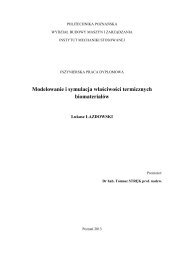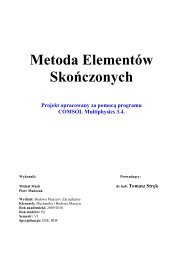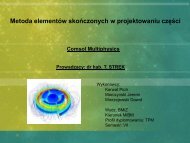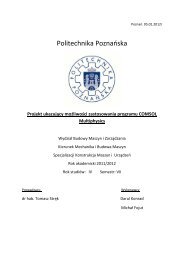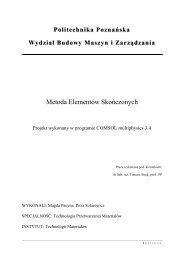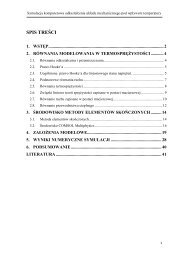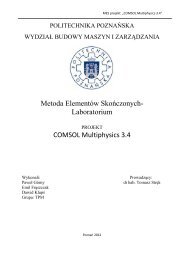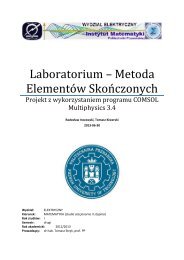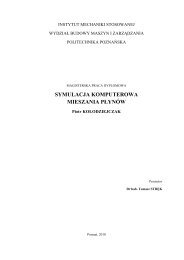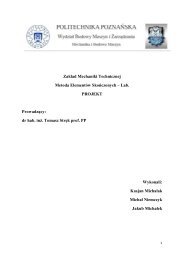Lithium-Ion Battery Simulation for Greener Ford Vehicles
Lithium-Ion Battery Simulation for Greener Ford Vehicles
Lithium-Ion Battery Simulation for Greener Ford Vehicles
Create successful ePaper yourself
Turn your PDF publications into a flip-book with our unique Google optimized e-Paper software.
ENERGY<br />
XI ENGINEERING CONSULTANTS LTD, EDINBURGH, UK<br />
Wind Turbine Noise Reduction<br />
Modeling of a megawatt wind turbine system enabled Xi Engineering Consultants to address a problematic<br />
tonal resonance with an innovative solution that minimized the cost of remedial work <strong>for</strong> their client.<br />
BY JENNIFER HAND<br />
Noise from wind farms falls into two<br />
categories: aerodynamic noise is created<br />
by the blades of a turbine swishing<br />
through the air while mechanical noise<br />
is associated with the machinery housed<br />
in the nacelle of a turbine. As mechanical<br />
noise tends to be tonal, it is this that is<br />
most often a nuisance factor <strong>for</strong> residents<br />
living nearby. As a result there are strict<br />
regulatory standards throughout Europe<br />
and North America and when operators<br />
do not meet these requirements they face<br />
potentially heavy penalties.<br />
“ Within this complex<br />
model we could see<br />
that there were certain<br />
hotspots near the top<br />
of the tower where the<br />
tower skin was rippling.”<br />
“People perceive noise, but often what<br />
they are really noticing is vibration,”<br />
comments Dr. Brett Marmo, Senior Consultant<br />
at Xi Engineering Consultants<br />
Ltd, an Edinburgh–based company that<br />
specializes in complex vibration issues.<br />
One of Xi’s recent projects was carried out<br />
<strong>for</strong> the manufacturer of a set of megawatt<br />
scale wind turbines emitting excessive<br />
noise in the 800-830 Hz frequency band.<br />
The manufacturer had already identified<br />
that the most likely source of<br />
noise was the meshing of teeth within<br />
the gearbox and in a major project had<br />
lifted the 15-ton gearbox out of one of<br />
the 80 m high towers and replaced the<br />
rubber buffers beneath it. This had only<br />
exacerbated the problem. It was not at<br />
all clear how the continuing noise could<br />
Wind Farm in the Scottish Southern Uplands.<br />
be addressed without considerable redesign<br />
and remedial work, which would be<br />
both expensive and disruptive, given the<br />
significant number of turbines involved.<br />
As Dr. Brett Marmo explains, “We were<br />
brought in to address this vibration by<br />
tracking it to the source.”<br />
Seeking the Source<br />
After a thorough study of existing design<br />
data and an extensive site survey in<br />
which sensors were attached to the turbine<br />
towers, Xi Engineering confirmed<br />
that the source of the noise was indeed<br />
the gearbox. “We were able to ascertain<br />
that at normal running speed the teeth on<br />
a set of gears make contact around 820<br />
times per second. In other words, we had<br />
the sound of 820 clashes each second,”<br />
notes Dr. Marmo. “However it was not<br />
that simple. The original noise was being<br />
amplified somehow and we suspected the<br />
involvement of the tower's steel skin. Every<br />
structure has a harmonic and in this<br />
case the tubular steel tower had a series<br />
of resonances between 800-900Hz.”<br />
1 2 // C O M S O L N E W S 2 0 1 1<br />
➮<br />
Cov ToC + – A<br />
➭<br />
12-14 CN XiEngineering 2011.indd 12 5/13/11 9:59 AM



